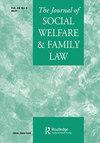‘Legacy benefits’ and the Universal Credit uplift: justified discrimination in the COVID-19 social security response
IF 0.9
Q2 LAW
引用次数: 0
Abstract
As the social security system creaked under the weight of the COVID-19 pandemic in 2020, a key dividing line emerged in the Secretary of State for Work & Pensions’ response. Characterised by Harris et al. (2020) as the ‘two-tier claimant hierarchy’, emergency increases in social security provision as the pandemic hit were targeted at those who had lost full-time work because of the pandemic, not those already in receipt of working-age benefits. Nowhere is this more apparent than in the ‘£20 uplift’ in Universal Credit (UC). In April 2020, the Government temporarily increased the ‘standard allowance’ in UC – the only benefit those newly out of work can claim – by £1,040 per year. However, they did not increase the ‘personal allowance’ in any so-called legacy benefits: payments such as Jobseekers Allowance, Employment and Support Allowance, Income Support and Working Tax Credit, which will eventually be replaced by UC. Although new claims for these legacy benefits are no longer possible, around 1.8 million people were claiming these payments when the pandemic began and, as a result, did not receive the uplift. The judgement in R (On the Application Of) T & Ors v Secretary of State for Work And Pensions [2022] EWHC 351 (Admin) interrogates the rationale for this ‘two-tier claimant hierarchy’ (Harris et al. 2020). The five claimants in this case were all in receipt of a legacy benefit and argued that the failure to uplift their payments was unlawfully discriminatory under Article 14 ECHR (prohibition of discrimination), taken with either Article 8 (the right to respect for the home) or A1P1 (the right to property). As the Secretary of State conceded that social security provision falls squarely under A1P1 – and neither side argued it would make any difference to the remaining issues whether A1P1 or Article 8 was the engaged right (para. 17) – the focus turned to whether there was discrimination against the claimants and, if so, if it could be justified. The first issue raises a significant question: can claimants in receipt of one social security payment (here, legacy benefits) be considered in a sufficiently analogous position to recipients of another (here, UC)? The Secretary of State argued that two separate benefits could not be compared in this way and, moreover, only one element of these particular benefits is relevant (i.e. the ‘standard allowance’ in UC and the ‘personal allowance’ in legacy benefits). It was not possible therefore, they argued, to allege discrimination between persons entitled to different benefits. The court dismissed these arguments, underscoring that the positions of the claimants and their comparator need“遗产福利”和普遍信贷提升:新冠肺炎社会保障应对中的合理歧视
2020年,随着社会保障体系在新冠肺炎疫情的压力下摇摇欲坠,工作与养老金国务秘书的应对措施出现了一条关键的分界线。Harris等人(2020)将其描述为“双层索赔人层级”,随着疫情的爆发,社会保障规定的紧急增加针对的是那些因疫情而失去全职工作的人,而不是那些已经领取工作年龄福利的人。这一点在环球信贷(UC)的“20英镑上调”中最为明显。2020年4月,政府暂时将UC的“标准津贴”——新失业者可以申请的唯一福利——每年增加1040英镑。然而,他们没有增加任何所谓的遗产福利中的“个人津贴”:如求职者津贴、就业和支持津贴、收入支持和工作税收抵免,这些福利最终将被UC取代。尽管这些遗产福利的新申请不再可能,但在疫情开始时,约有180万人申请了这些福利,因此没有得到提高。R(关于申请)T&Ors诉工作和养老金国务秘书【2022】EWHC 351(行政)一案的判决质疑了这种“双层索赔人等级制度”的理由(Harris等人,2020)。本案中的五名索赔人都获得了遗产福利,并辩称,根据《欧洲人权公约》第14条(禁止歧视)以及第8条(尊重住房的权利)或A1P1条(财产权),未能提高他们的付款是非法歧视。由于国务卿承认,社会保障条款完全属于A1P1条款——双方都没有辩称,A1P1或第8条是否是参与权利对其余问题有任何影响(第17段)——焦点转向了是否存在对索赔人的歧视,如果存在,是否有正当理由。第一个问题提出了一个重要问题:领取一笔社会保障金(此处为遗产福利)的申请人是否可以被视为与另一笔(此处为UC)的受益人处于足够相似的地位?国务卿辩称,不能以这种方式比较两种单独的福利,而且,这些特定福利中只有一个要素是相关的(即UC中的“标准津贴”和遗产福利中的“个人津贴”)。因此,他们认为,不可能指控享有不同福利的人之间存在歧视。法院驳回了这些论点,强调索赔人及其比较人的立场需要
本文章由计算机程序翻译,如有差异,请以英文原文为准。
求助全文
约1分钟内获得全文
求助全文
来源期刊
CiteScore
2.00
自引率
13.30%
发文量
52
期刊介绍:
The Journal of Social Welfare & Family Law is concerned with social and family law and policy in a UK, European and international context. The policy of the Editors and of the Editorial Board is to provide an interdisciplinary forum to which academics and professionals working in the social welfare and related fields may turn for guidance, comment and informed debate. Features: •Articles •Cases •European Section •Current Development •Ombudsman"s Section •Book Reviews

 求助内容:
求助内容: 应助结果提醒方式:
应助结果提醒方式:


